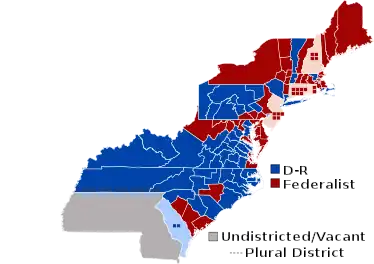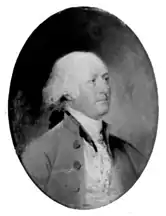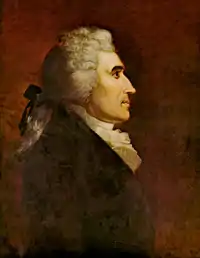| 5th United States Congress | |
|---|---|
4th ← → 6th | |
 Congress Hall (2007) | |
March 4, 1797 – March 3, 1799 | |
| Members | 32 senators 106 representatives |
| Senate majority | Federalist |
| Senate President | Thomas Jefferson (DR) |
| House majority | Federalist |
| House Speaker | Jonathan Dayton (F) |
| Sessions | |
| Special: March 4, 1797 – March 4, 1797 1st: May 15, 1797 – July 10, 1797 2nd: November 13, 1797 – July 16, 1798 Special: July 17, 1798 – July 19, 1798 3rd: December 3, 1798 – March 3, 1799 | |
The 5th United States Congress was a meeting of the legislative branch of the United States federal government, consisting of the United States Senate and the United States House of Representatives. It met at Congress Hall in Philadelphia, Pennsylvania, from March 4, 1797, to March 4, 1799, during the first two years of John Adams' presidency. In the context of the Quasi-War with France, the Alien and Sedition Acts were passed by Congress. The Acts were overwhelmingly supported by the Federalists and mostly opposed by the Democratic-Republicans. Some Democratic-Republicans, such as Timothy Bloodworth, said they would support formally going to war against France but they opposed the Alien and Sedition Acts which Bloodworth and others believed were unconstitutional.[1]
The apportionment of seats in this House of Representatives was based on the 1790 United States census. Both chambers had a Federalist majority.
.png.webp)
Major events
- March 4, 1797 – John Adams became President of the United States
- July 8, 1797 – The Senate expelled Tennessee Senator William Blount for conspiring with the British
- July 11, 1798 – The United States Marine Corps was established
- XYZ Affair in the U.S., followed by naval skirmishes but no war is declared. The XYZ affair led to several Democratic-Republicans breaking ranks with Thomas Jefferson. Jefferson took pains to avoid blaming France for the incident, as a result John Hunter, Josiah Tattnall, Timothy Bloodworth, Alexander Martin, Lemuel Benton, Thomas Sumter, William Smith, John Milledge, Abraham Baldwin, Joseph McDowell, Matthew Locke, Robert Williams, Richard Stanford, Nathaniel Macon, James Gillespie, Dempsey Burges, Thomas Blount, Nathan Bryan, John Brown, Thomas T. Davis, John Fowler and Joseph Anderson all publicly broke ranks with Jefferson, despite the fact he was the de facto leader of their party, and sided with Alexander Hamilton. The aforementioned congressmen and senators were referred to by Jefferson as a "reign of witches" and were described as the "Pro-British republicans" (as opposed to the "pro-French republicans" led by Jefferson).[2]
Major legislation
- April 7, 1798: Mississippi Organic Act ("An Act for an amicable settlement of limits with the state of Georgia, and authorizing the establishment of a government in the Mississippi territory"), Sess. 2, ch. 28, 1 Stat. 549
- April 30, 1798: The U.S. Department of the Navy was established, Sess. 2, ch. 35, 1 Stat. 553
- June 18, 1798: Alien and Sedition Acts: ("An Act to establish a uniform rule of naturalization") (Naturalization Act of 1798), Sess. 2, ch. 54, 1 Stat. 566
- June 25, 1798: Alien and Sedition Acts: ("An Act concerning Aliens"), Sess. 2, ch. 58, 1 Stat. 570
- July 6, 1798: Alien and Sedition Acts: ("An Act respecting Alien Enemies"), Sess. 2, ch. 66, 1 Stat. 577
- July 9, 1798: Act Further to Protect the Commerce of the United States, Sess. 2, ch. 68, 1 Stat. 578
- July 11, 1798: The United States Marine Corps was established, Sess. 2, ch. 72, 1 Stat. 594
- July 14, 1798: Alien and Sedition Acts: ("An Act for the punishment of certain crimes against the United States") (Sedition Act), Sess. 2, ch. 74, 1 Stat. 596
- July 16, 1798: Marine Hospital Service Act ("An Act for the relief of sick and disabled Seamen"), Sess. 2, ch. 77, 1 Stat. 605
Treaties ratified
- June 7, 1797: Treaty of Tripoli between the United States and Tripoli.[3]
- July 7, 1797: Existing treaties with France were rescinded, Sess. 2, ch. 67, 1 Stat. 578
Party summary
Details on changes are shown below in the "Changes in membership" section.
Senate
| Party (shading shows control) |
Total | Vacant | ||
|---|---|---|---|---|
| Democratic- Republican (DR) |
Federalist (F) | |||
| End of previous congress | 11 | 21 | 32 | 0 |
| Begin | 9 | 22 | 31 | 1 |
| End | ||||
| Final voting share | 29.0% | 71.0% | ||
| Beginning of next congress | 9 | 22 | 31 | 1 |
House of Representatives

| Party (shading shows control) |
Total | Vacant | ||
|---|---|---|---|---|
| Democratic- Republican (DR) |
Federalist (F) | |||
| End of previous congress | 59 | 47 | 106 | 0 |
| Begin | 49 | 56 | 105 | 1 |
| End | 50 | 106 | 0 | |
| Final voting share | 47.2% | 52.8% | ||
| Beginning of next congress | 46 | 60 | 106 | 0 |

Leadership
Senate
- President: Thomas Jefferson (DR)
- President pro tempore: William Bradford (F), elected July 6, 1797
- Jacob Read (F), elected November 22, 1797
- Theodore Sedgwick (F), elected June 27, 1798
- John Laurance (F), elected December 6, 1798
- James Ross (F), elected March 1, 1799
House of Representatives
Members
This list is arranged by chamber, then by state. Senators are listed in order of seniority, and representatives are listed by district.
Senate
Senators were elected by the state legislatures every two years, with one-third beginning new six-year terms with each Congress. Preceding the names in the list below are Senate class numbers, which indicate the cycle of their election. In this Congress, Class 1 meant their term began in this Congress, requiring reelection in 1802; Class 2 meant their term ended with this Congress, requiring reelection in 1798; and Class 3 meant their term began in the last Congress, requiring reelection in 1800.
Connecticut
Delaware
Georgia
Kentucky
Maryland
Massachusetts
New Hampshire
New Jersey
New York
|
North Carolina
Pennsylvania
Rhode Island
South Carolina
Tennessee
Vermont
Virginia
|
 Senators' party membership by state at the opening of the 5th Congress in March 1797.
2 Democratic-Republicans
1 Democratic-Republican and 1 Federalist
2 Federalists |
 President pro tempore of the Senate Jacob Read
|
House of Representatives
Changes in membership
The count below reflects changes from the beginning of this Congress
Senate
There were 9 resignations, 2 deaths, 1 expulsion, 1 late selection, and 2 elections to replace appointees. Neither party had a net gain of seats.
| State (class) |
Vacated by | Reason for change | Successor | Date of successor's formal installation[lower-alpha 1] |
|---|---|---|---|---|
| Tennessee (1) |
Vacant | Tennessee failed to elect a Senator on time | William Cocke (DR) | Appointed May 15, 1797 |
| Tennessee (2) |
William Blount (DR) | Expelled July 8, 1797 | Joseph Anderson (DR) | Elected September 26, 1797 |
| Tennessee (1) |
William Cocke (DR) | Interim appointment until September 26, 1797 | Andrew Jackson (DR) | Elected September 26, 1797 |
| Rhode Island (2) |
William Bradford (F) | Resigned sometime in October, 1797 | Ray Greene (F) | Elected November 13, 1797 |
| Vermont (1) |
Isaac Tichenor (F) | Resigned October 17, 1797 | Nathaniel Chipman (F) | Elected October 17, 1797 |
| Maryland (3) |
John Henry (F) | Resigned December 10, 1797 | James Lloyd (F) | Elected December 11, 1797 |
| New York (1) |
Philip John Schuyler (F) | Resigned January 3, 1798 | John Sloss Hobart (F) | Elected January 11, 1798 |
| Delaware (2) |
John Vining (F) | Resigned January 19, 1798 | Joshua Clayton (F) | Elected January 19, 1798 |
| Tennessee (1) |
Andrew Jackson (DR) | Resigned sometime in April, 1798 | Daniel Smith (DR) | Appointed October 6, 1798 |
| New York (1) |
John Sloss Hobart (F) | Resigned April 16, 1798 | William North (F) | Appointed May 5, 1798 |
| Delaware (2) |
Joshua Clayton (F) | Died August 11, 1798 | William H. Wells (F) | Elected January 17, 1799 |
| New York (1) |
William North (F) | Interim appointment until August 17, 1798 | James Watson (F) | Elected August 17, 1798 |
| New Jersey (1) |
John Rutherfurd (F) | Resigned November 26, 1798 | Franklin Davenport (F) | Appointed December 5, 1798 |
| South Carolina (2) |
John Hunter (DR) | Resigned November 26, 1798 | Charles Pinckney (DR) | Elected December 6, 1798 |
| Virginia (2) |
Henry Tazewell (DR) | Died January 24, 1799 | Vacant | Not filled in this Congress |
House of Representatives
There were 9 resignations and 3 deaths. The Federalists had a 1-seat net loss and the Democratic-Republicans had a 1-seat net gain.
| District | Vacated by | Reason for change | Successor | Date of successor's formal installation[lower-alpha 1] |
|---|---|---|---|---|
| Vermont 2 | Vacant | Daniel Buck (F) had been re-elected, but declined to serve. Successor elected May 23, 1797.[4] |
Lewis R. Morris (F) | May 24, 1797 |
| Rhode Island at-large | Elisha Potter (F) | Resigned sometime in 1797. Successor elected August 29, 1797.[4] |
Thomas Tillinghast (F) | Seated November 13, 1797 |
| South Carolina 1 | William L. Smith (F) | Resigned July 10, 1797. Successor elected September 4–5, 1797.[4] |
Thomas Pinckney (F) | Seated November 23, 1797 |
| Massachusetts 11 | Theophilus Bradbury (F) | Resigned July 24, 1797. Successor elected August 4, 1797.[4] |
Bailey Bartlett (F) | Seated November 27, 1797 |
| New Hampshire at-large | Jeremiah Smith (F) | Resigned July 26, 1797. Successor elected August 28, 1797.[4] |
Peleg Sprague (F) | Seated December 15, 1797 |
| Connecticut at-large | James Davenport (F) | Died August 3, 1797. Successor elected September 18, 1797.[4] |
William Edmond (F) | Seated November 13, 1797 |
| Tennessee at-large | Andrew Jackson (DR) | Resigned sometime in September 1797 to become U.S. Senator. Successor elected September 26, 1797.[5] |
William C.C. Claiborne (DR) | Seated November 23, 1797 |
| Pennsylvania 5 | George Ege (F) | Resigned sometime in October 1797. Successor elected October 10, 1797.[4] |
Joseph Hiester (DR) | Seated December 1, 1797 |
| Pennsylvania 4 | Samuel Sitgreaves (F) | Resigned sometime in 1798. Successor elected October 9, 1798.[4] |
Robert Brown (DR) | Seated December 4, 1798 |
| North Carolina 10 | Nathan Bryan (DR) | Died June 4, 1798. Successor elected August 2, 1798.[4] |
Richard Dobbs Spaight (DR) | Seated December 10, 1798 |
| Pennsylvania 1 | John Swanwick (DR) | Died July 31, 1798. Successor elected October 9, 1798.[4] |
Robert Waln (F) | Seated December 3, 1798 |
| Connecticut at-large | Joshua Coit (F) | Died September 5, 1798. Successor elected October 22, 1798.[4] |
Jonathan Brace (F) | Seated December 3, 1798 |
| Virginia 9 | William Giles (DR) | Resigned October 2, 1798. Successor elected November 1, 1798.[4] |
Joseph Eggleston (DR) | Seated December 3, 1798 |
Committees
Lists of committees and their party leaders.
Senate
House of Representatives
- Claims (Chairman: Dwight Foster)
- Commerce and Manufactures (Chairman: Edward Livingston then Samuel Smith)
- Elections (Chairman: Joshua Coit then Joseph B. Varnum)
- Revisal and Unfinished Business (Chairman: Jeremiah Smith then Nathaniel Macon then George Thatcher)
- Rules (Select)
- Standards of Official Conduct
- Ways and Means (Chairman: William L. Smith then Robert Goodloe Harper)
- Whole
Joint committees
- Enrolled Bills (Chairman: Isaac Tichenor)
Employees
Senate
House of Representatives
- Clerk: John J. Beckley, until May 15, 1797
- Jonathan W. Condy, elected May 15, 1797
- Sergeant at Arms: Joseph Wheaton
- Doorkeeper: Thomas Claxton
- Reading Clerks: [data missing]
- Chaplain: Ashbel Green, Presbyterian
See also
- 1796 United States elections (elections leading to this Congress)
- 1798 United States elections (elections during this Congress, leading to the next Congress)
Notes
References
- ↑ The Presidency of John Adams by Ralph A. Brown, University Press of Kansas, 1975
- ↑ The Reign of Witches: The Struggle Against the Alien and Sedition Laws, 1789-1800 by Elizabeth Lawson
- ↑ "Executive Journal (Fourteenth session)". Journal of the Executive Proceedings of the Senate of the United States of America. Library of Congress. June 7, 1797. p. 244.
- 1 2 3 4 5 6 7 8 9 10 11 12 Date cited is the election date, but the winner in some cases "took" his seat on a later date. See Dubin, Michael J. (1998). United States Congressional Elections, 1788-1997: The Official Results of the Elections of the 1st Through 105th Congresses. McFarland and Company. ISBN 0786402830.
- ↑ Election date, but winner was seated later. See https://elections.lib.tufts.edu/catalog/tufts:tn.ushouserepresentatives.1797 Archived March 11, 2020, at the Wayback Machine
- Martis, Kenneth C. (1989). The Historical Atlas of Political Parties in the United States Congress. New York: Macmillan Publishing Company.
- Martis, Kenneth C. (1982). The Historical Atlas of United States Congressional Districts. New York: Macmillan Publishing Company.
